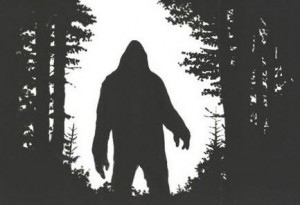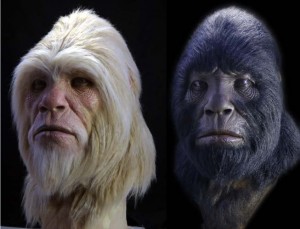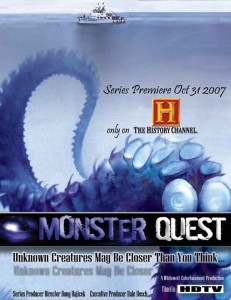 Mythologist and folklorist Gary Varner was a recent guest here answering questions about the origins, history, and expressions of gargoyles and grotesques. He has researched a variety of subjects and is the author of Creatures in the Mist: Little People, Wild Men and Spirit Beings around the World: A Study of Comparative Mythology (Algora Publishing, 2007). The publisher’s website provides the following description:
Mythologist and folklorist Gary Varner was a recent guest here answering questions about the origins, history, and expressions of gargoyles and grotesques. He has researched a variety of subjects and is the author of Creatures in the Mist: Little People, Wild Men and Spirit Beings around the World: A Study of Comparative Mythology (Algora Publishing, 2007). The publisher’s website provides the following description:
Folklore around the world reflects mankind’s abiding interest in other-worldly creatures including vampires, werewolves, giants, fairies, and spirit beings. This easy-reading compendium will have a broad appeal among the general public. This book will delight everyone who is fascinated with tales of fairies, mystical beings around the world, and the legends and fairytales that feed our imagination.
Gary returns to discuss mythology and mysterious creatures.
TheoFantastique: Gary, thank you for coming back to discuss another of your research areas. As we consider fantastic creatures from various cultures throughout history, including in the present, how does mythological and folkloric studies help provide important considerations for us?
Gary Varner: Myth and folklore link all of us to a common thread. Our pasts in regards to our specific origins, ethnic roots and cultures may be different but we find many commonalities in our folklore and collective mythology. Because so many legends are almost identical, such as those connected with the Yeti, Bigfoot, and Sasquatch it is also very possible that these creatures did and possibly still do exist.
TheoFantastique: What is the basic thesis of your book Creatures in the Mist?
Gary Varner: I have pulled certain themes together to show that similar stories can be found the world over and throughout time concerning mermaids, sea monsters, gigantic bipeds and the little people or fairy. I am always interested in why the stories are so similar even though the geographic areas may be so far apart. Could it be that the “Hobbit” people of Flores Island may have been the origin for legends about little people? Or were there many such ancient groups around the world which resulted in such a widespread belief in these mystical creatures?
TheoFantastique: Can you share a couple of examples of creatures that appear in various cultures, and the types of similarities that may be found among them across cultures?
 Gary Varner: The “wild man” or Bigfoot is perhaps the best known of a creature that is recognizable around the world. From the Pacific Northwest to the forests of Russia, China, Europe Central and South America these creatures are always described in the same fashion: very large bipeds with long fur or hair, tailless and normally dangerous. The little people are also well known around the world. They are normally said to be helpful to humans, fond of music and dancing and sometime can heal. But they have also been described as malicious or mean spirited and tricksters. Many Native American legends about the little people indicate that they live in or near water sources and in rock areas. Other than being very tiny, they are often described as appearing in human form but always with very long hair. Little people have become part of legend from North America, Polynesia, Ireland (of course), Wales, Canada, New Guinea, Russia and South America.
Gary Varner: The “wild man” or Bigfoot is perhaps the best known of a creature that is recognizable around the world. From the Pacific Northwest to the forests of Russia, China, Europe Central and South America these creatures are always described in the same fashion: very large bipeds with long fur or hair, tailless and normally dangerous. The little people are also well known around the world. They are normally said to be helpful to humans, fond of music and dancing and sometime can heal. But they have also been described as malicious or mean spirited and tricksters. Many Native American legends about the little people indicate that they live in or near water sources and in rock areas. Other than being very tiny, they are often described as appearing in human form but always with very long hair. Little people have become part of legend from North America, Polynesia, Ireland (of course), Wales, Canada, New Guinea, Russia and South America.
TheoFantastique: Do you see any similarities or relationships between the stories of the Wild Men or Giants of cultures in times past and contemporary stories of Bigfoot or Yeti?
Gary Varner: Yes although the Wild Men legends differ in that they sometimes describe creatures of small and sometimes dwarf stature and even appearing as goblins. Their appearances seem to vary depending on the region. Wild people in the forested areas of Europe were said to be of gigantic proportion while those in the jungles of Belize are only four feet six in height at the maximum. All, however, have hairy bodies, are powerful and often said to be extremely fast. The origin of the “Wild Man” legends seem to date to the Middle Ages and may have described bands of social outcasts, living on the fringe of society.
The other legends such as those about Yeti, Bigfoot etc., are entirely different in that they invariably describe a more primitive type of creature.
Giants, however, have and still do exist to some degree. In Greek mythology giants were primordial deities. Giants are common in Native American lore and while most of them are supernatural creatures there are a few legends that speak of giants as beings from other lands as human as you and I. The Cherokee, for example, have a legend of a party of giants that visited Cherokee villages in the 17th century. Said to be twice as tall as common men with slanted eyes, they reportedly “lived very far away in the direction in which the sun goes down.” And, of course the Bible tells of a land of giants that were hunted down and slaughtered by the Hebrews. The interesting thing about these legends is how they were told as historical “events” and not as myth.
 TheoFantastique: When I was growing up in the 1970s I enjoyed the program In Search of… that explored various paranormal phenomenon, including cryptozoology, and the contemporary program Monster Quest that does the same. Unfortunately, these programs are usually often disappointing in terms of holding out promise of the alleged existence of fantastic creatures that may inform our folklore and myths, but the evidence is usually lacking. Any thoughts on this?
TheoFantastique: When I was growing up in the 1970s I enjoyed the program In Search of… that explored various paranormal phenomenon, including cryptozoology, and the contemporary program Monster Quest that does the same. Unfortunately, these programs are usually often disappointing in terms of holding out promise of the alleged existence of fantastic creatures that may inform our folklore and myths, but the evidence is usually lacking. Any thoughts on this?
Gary Varner: Yes, I enjoy Monster Quest now too but always know that any actual creature that they are looking for will never likely be found. They are entertaining and I think that they are worthwhile in that they provide “possibilities” that people should consider. We all need the unknown, the possibility that unusual creatures do exist, that the world is more than what we see everyday to keep ourselves grounded. We need to keep myth alive and who knows, previously unknown and thought to be extinct animals continue to be found so why not keep looking for these mystical beings?
TheoFantastique: Gary, thank you again for your book and your research interests that overlap with that of TheoFantastique.
Gary Varner: Thank you. It’s been a pleasure!





Cryptozoology is fascinating, one of the last fields of study where modern man and myth can still interact. My personal favorite is the El Chupacabra: When Vampires, Aliens and reptilians untie.
John, that picture of the yeti/sasquatch is amazing. Where is it from?
Moses, thank you for your comments and shared interests in cryptozoology. I must admit my own interets in the Chupacabra, particularly with the interesting video footage from a police dash came a while back of a strange looking dog-like animal with what looked like sharp teeth that was similar to some of the descriptions of the creature. As to the yeti/sasquatch picture, do you mean the silhouette or the masks? Regardless, I just did a simple Google image search on Bigfoot as well as mythical creatures and came across these images.
As “El Chupacabra” grows in notoriety it makes me proud as a Puerto Rican American that our small island has given birth to one of the worlds newest myths.
It has become a whole business on the island with images, t-shirts, toys, and books. The Chupacabra is Puerto Rican.
Even Hollywood is getting into the picture. I just hope better movies are done of this amazing creature. Sy-Fy’s “Chupacabra: Dark Waters” now called “Chupacabra terror” was a travesty. Puerto Rican will not stand for such disrespect. Viva, El Chupacabra!
Look at this little Chupacabra!! He’s so cute!!
http://www.ecrater.com/p/2795139/chupacabra-plush-stuffed-animal